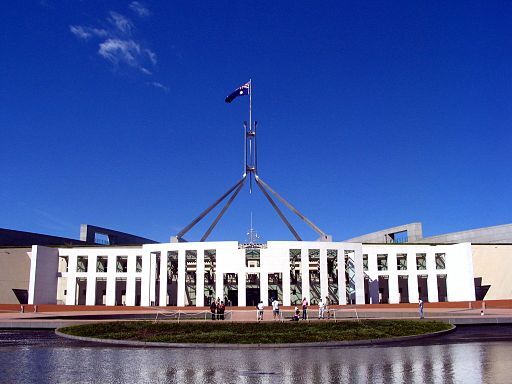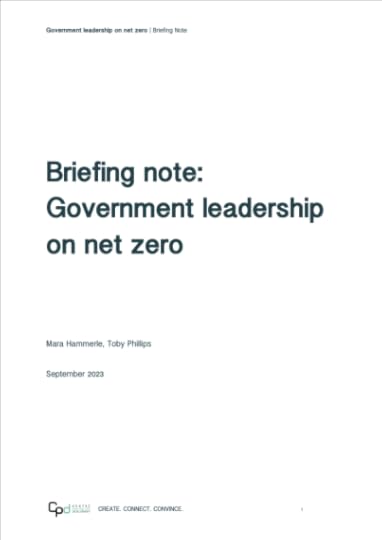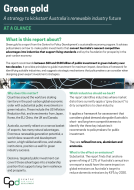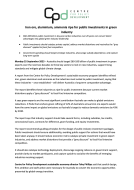Centre for Policy Development's Blog, page 6
October 2, 2023
Government leadership on net zero briefing note

The Centre for Policy Development has produced a briefing note setting out key elements of net zero leadership for government.
The Government Leadership on Net Zero briefing note by Dr Mara Hammerle and Toby Phillips. It sets out three key dimensions of government leadership on net zero.
They are:
Ambition: a leading net zero programhas a challenging timeline and scale of
action. It includes scope 3 emissions
alongside scope 1 and 2 emissions. Innovation: leadership requires true
change to internal systems, eg. internal
carbon pricing. Honesty: leadership means clear and
consistent reporting on aspects such as
progress against clear emissions
benchmarks, but also setbacks or
unexpected difficulties.
 Read the Briefing Note [PDF]
Read the Briefing Note [PDF]The post Government leadership on net zero briefing note appeared first on Centre for Policy Development.
September 28, 2023
Plan for policymakers to seize a renewable energy future for the post-carbon world
September 24, 2023
Five key changes to welfare and work rules in Labor’s employment white paper
Industry urged to club together in clean energy hubs
Debelle backs $100b push on green exports
Kick-starting green exports will need up to $100b: Report
MEDIA RELEASE: Employment White Paper identifies early childhood, employment services as key to future of work
Monday 25 September 2023 – Today’s Employment White Paper presents a bold reform plan to reignite productivity growth through building a skilled future-ready workforce, helping people overcome barriers to work and broadening opportunities for all Australians.
It sets Australia’s sights on delivering decent work and economic security for all, and highlights their important place in supporting the wellbeing of current and future generations.
It also illustrates the vital role that employment services and early childhood development will play in delivering sustained, inclusive full employment.
The Centre for Policy Development (CPD) submission to Treasury identified the great importance of these areas of public policy as well, alongside people- and place-centred reform approaches.
Centre for Policy Development Deputy CEO Annabel Brown, said that each of these areas were vital to Australia’s future wellbeing and prosperity.
“The early childhood sector is recognised as critical social infrastructure enabling workforce participation, a key job creation engine in the care economy, and a profound contribution to thriving future generations.
“Creating a universally accessible, high quality early childhood education and care system will boost long-term productivity, help more women and parents enter the workforce, and strengthen the care sector.
“Access to quality early childhood education, as part of a connected early childhood development system parents can rely on, will see gains for current and future generations by building foundational skills and setting children up for success in later life.
“On employment services, CPD emphasises the need for the government to become a more active player in service delivery, and to build a locally focused service system, available to anyone that needs it, that better connects jobseekers with decent, sustainable work with local employers and industry. This will require a mindset shift and an uplift in public sector capability.
“Government needs to get back in the game, on the side of people, providers, employers and communities.
“The White Paper shows how important thorough, long-term and far-reaching service system reform is after the travesty of robodebt. We are hopeful the ongoing Workforce Australia inquiry will set us on this course.”
“People- and place-centred policy reform connects government with people and communities to build on their strengths, and meet their needs more closely.
“It’s encouraging that we are seeing the federal government consider the more active, collaborative approach to employment and other services that has been a success at a local level in countless initiatives across Australia.”
ENDS
Media release: Iron ore, aluminium, ammonia ripe for public investments in green industry
Monday 25 September 2023 – Australia should target $60-100 billion of public investment in green exports over the next two decades to three key sectors to lock in new industries, support living standards and mitigate global climate change.
The Green gold report from the Centre for Policy Development’s sustainable economy program identifies refined iron, green aluminium and ammonia as the industries most suited to public investment, saying that these industries – once established – will deliver Australia a long term comparative advantage.
The report identifies these industries as ripe for public investment because current market distortions apply a “grey discount” to fossil-fuel intensive competitors.
It says green exports are the most significant contribution Australia can make to global emissions reductions. It finds that onshore green refining of 12% of Australia’s annual iron ore exports would have the same impact on global emissions as Australia’s target to reduce domestic emissions by 43% by 2030.
The report says that industry support should take several forms, including subsidies, tax credits, concessional loans, contracts for difference, grant funding, and equity investments.
The report recommends guiding principles for the design of public industry investment packages. Public investment should ensure additionality, avoiding public support for actions that would have been taken anyway. It should reduce economic risk to catalyse private investment in green export industries, and address market distortions that provide a “grey discount” to fossil-fuel intensive competitors.
It should also catalyse technology deployment, discourage ongoing reliance on government support, provide clarity to market participants, and capture upside to socialise the benefits of emerging industries receiving support.
Centre for Policy Development sustainable economy director Toby Phillips said that careful design, firm ambition and swift action were necessary for Australia to convert the economic opportunities presented by global energy transition.
“Australia is famously well-positioned to become an industrial powerhouse in the post-carbon economy thanks to our abundant natural resources, our unmatched potential for renewable energy generation, our highly skilled workforce, our stable institutions and our world-class research and development,” Mr Phillips said.
“Transforming these advantages into a leadership position requires us to take strategic, decisive and well-designed action that will create new export industries, support living standards, mitigate climate change and make our economy resilient and prosperous in the post-carbon era.
“By carefully selecting the right industries for the right investment at this crucial time, we can lock in future industries and make an important dint in global emissions, putting Australia at the head of the pack for industrial and economic leadership over the coming decades.”
ENDS
September 23, 2023
MEDIA RELEASE: Employment White Paper identifies early childhood, employment services as key to future of work
Monday 25 September 2023 – Today’s Employment White Paper presents a bold reform plan to reignite productivity growth through building a skilled future-ready workforce, helping people overcome barriers to work and broadening opportunities for all Australians.
It sets Australia’s sights on delivering decent work and economic security for all, and highlights their important place in supporting the wellbeing of current and future generations.
It also illustrates the vital role that employment services and early childhood development will play in delivering sustained, inclusive full employment.
The Centre for Policy Development (CPD) submission to Treasury identified the great importance of these areas of public policy as well, alongside people- and place-centred reform approaches.
Centre for Policy Development Deputy CEO Annabel Brown, said that each of these areas were vital to Australia’s future wellbeing and prosperity.
“The early childhood sector is recognised as critical social infrastructure enabling workforce participation, a key job creation engine in the care economy, and a profound contribution to thriving future generations.
“Creating a universally accessible, high quality early childhood education and care system will boost long-term productivity, help more women and parents enter the workforce, and strengthen the care sector.
“Access to quality early childhood education, as part of a connected early childhood development system parents can rely on, will see gains for current and future generations by building foundational skills and setting children up for success in later life.
“On employment services, CPD emphasises the need for the government to become a more active player in service delivery, and to build a locally focused service system, available to anyone that needs it, that better connects jobseekers with decent, sustainable work with local employers and industry. This will require a mindset shift and an uplift in public sector capability.
“Government needs to get back in the game, on the side of people, providers, employers and communities.
“The White Paper shows how important thorough, long-term and far-reaching service system reform is after the travesty of robodebt. We are hopeful the ongoing Workforce Australia inquiry will set us on this course.”
“People- and place-centred policy reform connects government with people and communities to build on their strengths, and meet their needs more closely.
“It’s encouraging that we are seeing the federal government consider the more active, collaborative approach to employment and other services that has been a success at a local level in countless initiatives across Australia.”
ENDS
The post MEDIA RELEASE: Employment White Paper identifies early childhood, employment services as key to future of work appeared first on Centre for Policy Development.
September 20, 2023
Green gold – A strategy to kickstart Australia’s renewable industry future

Green gold is a report from the Centre for Policy Development’s sustainable economy program.
It advises policymakers on how to make public investments that convert Australia’s nascent competitive advantages into industries that support living standards and lay the foundation for prosperity in the post-carbon economy.
The report recommends between $60 and $100 billion of public investment in green industry over two decades.
It provides principles to guide investment for maximum impact, describes a framework for identifying suitable industries, and suggests strategic mechanisms that policymakers can consider when designing green export investment strategies.
 Read the Report [PDF]
Read the Report [PDF]
 At A Glance
At A Glance
 Media release Why does this matter?
Media release Why does this matter?
Countries around the world are staking territory in the post-carbon global economic order with substantial public investments in green industry. These include the US Inflation Reduction Act, and investments from Japan, Korea, the EU, China, the UK and Canada.
Australia, currently reliant on a narrow basket of exports, has many natural advantages. Enormous renewable generation potential, a world-class research and development sector, a high-skilled workforce, and stable institutions, position us well for green industry success.
Decisive, targeted public investment can covert these advantages into a leadership position that supports long-term resilience and prosperity.
Which industries should we back?The report identifies three industries where market distortions currently apply a “grey discount“ to dirty competitors to clean industry.
It applies a framework for assessment that considers global demand alongside Australia’s short- and long-term competitiveness to identify the three key industries it recommends to policymakers for public investment.
They are refined iron ore, aluminium and ammonia.
What is the effect on emissions?The report finds that onshore green refining of 12% of Australia’s annual iron ore exports would have the same impact on global emissions as Australia’s target to reduce domestic emissions by 43% by 2030.
What principles should guide public investment?Public investment should be strategically designed and targeted to ensure impact. The report suggests that beyond careful industry selection, investment should:
Ensure additionality, avoiding public support for actions that would have been taken anywayReduce economic risk to catalyse private investment in green export industriesAddress the “grey discount” that market distortions currently apply to some dirty productsEncourage technology deployment and innovation to hasten commercial application of new green technologiesBe “front-loaded” to secure momentum during a critically competitive period to establish green industries and reduce emissions globallyBe designed to phase out and avoid creating commercial industries that have an ongoing reliance of public spending for survivalBe simple and clear for market participantsEnable public investors to capture upside so that returns on public investments can be reinvested in the national interest What else do we need?Australia can become a green industry superpower. Getting there means dramatically expanding our renewable energy generation – maybe to 10 times the current national electricity market (NEM).
Other challenges include managing workforce readiness and mitigating inflationary risk.
The paper also notes that other measures unrelated to export industries are necessary, such as subsidies for domestic consumers, household electrification and efficiency, community development, climate adaptation, and environmental protection.
The post Green gold – A strategy to kickstart Australia’s renewable industry future appeared first on Centre for Policy Development.
Centre for Policy Development's Blog
- Centre for Policy Development's profile
- 1 follower



